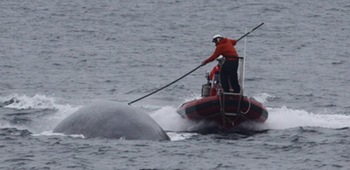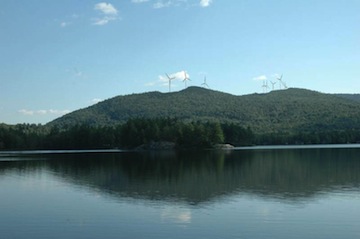Follow SOCAL D-tag and controlled exposure field work at SEABlog
Default Comments Off on Follow SOCAL D-tag and controlled exposure field work at SEABlog As usual, Brandon Southall is posting regularly from sea as his research team begins the third year of a five year Behavioral Response Study off the coast of southern California. The field work is largely focused on conducting controlled exposure experiments (CEE) on a fairly wide variety of species, in order to learn more about how each species responds to various types of sounds. Animals are approached in zodiacs in order to attach Dtags (temporary suction-cup tags that record sounds heard and produced by the animal, as well as detailed three-dimensional dive patterns) or one of several other types of tags; once the tag has been on long enough for the animal to relax after that tagging approach, a larger ship maneuvers in to position and transmits sequence of test sounds. So far, test sounds have been a simulated mid-frequency active sonar signal (peaking at 25dB quieter than the Navy uses) and a pseudo-random noise stimulus. For background on this year’s study objectives, see the SOCAL-12 informational webpage.
As usual, Brandon Southall is posting regularly from sea as his research team begins the third year of a five year Behavioral Response Study off the coast of southern California. The field work is largely focused on conducting controlled exposure experiments (CEE) on a fairly wide variety of species, in order to learn more about how each species responds to various types of sounds. Animals are approached in zodiacs in order to attach Dtags (temporary suction-cup tags that record sounds heard and produced by the animal, as well as detailed three-dimensional dive patterns) or one of several other types of tags; once the tag has been on long enough for the animal to relax after that tagging approach, a larger ship maneuvers in to position and transmits sequence of test sounds. So far, test sounds have been a simulated mid-frequency active sonar signal (peaking at 25dB quieter than the Navy uses) and a pseudo-random noise stimulus. For background on this year’s study objectives, see the SOCAL-12 informational webpage.
In addition, researchers on the cruise pursue other related studies, including ongoing visual observation surveys, tests of new acoustic monitoring systems, and trials of new research methodologies for monitoring behavior of non-tagged animals for possible future exposure studies. A summary of last year’s field work can be downloaded at the SOCAL-11 website; SOCAL-11 succeeded in attaching 38 tags of four different types on 35 individuals of four different marine mammal species. For the suction cup acoustic/position tags used in SOCAL?11 (not including the satellite tags), this resulted in nearly 200 hours of tag data across these individuals, the majority resulting from Dtag deployments. Thirteen complete CEE sequences were conducted, involving 13 blue whales, 4 Risso’s dolphins, and 1 Cuvier’s beaked whale. Preliminary analysis of dive patterns suggest that blue whales and Risso’s dolphins showed little response to the sounds (though the dolphins were resting at the surface during the CEEs; deep diving behavior has not been taking place during CEE’s so far), while the beaked whale showed “a similar relatively strong response at low received level (ed. note: peak of 135-140dB re 1 uPa, with behavioral response initiated when the signal was not much above background ambient) as was observed in SOCAL-10.”

 One year-round resident notes that the noise is loudest when his home is downwind of the turbines, and adds, “What is most interesting to me is that they seem loudest on the calmer days. That is, if the wind is barely existent, I can really hear them roaring.”
One year-round resident notes that the noise is loudest when his home is downwind of the turbines, and adds, “What is most interesting to me is that they seem loudest on the calmer days. That is, if the wind is barely existent, I can really hear them roaring.” I guess the third time was the charm for John McCain in his relentless quest to undermine the National Park Service’s decades-long effort to slightly reduce aircraft overflight impacts in the Grand Canyon backcountry. Since the NPS released its draft plan several months ago, McCain had crafted amendments to a couple of pieces of legislation in an effort to codify the status quo overflight rules; this week, it was inserted into the Transportation bill that was passed by the House and Senate and quickly signed by President Obama. The Arizona and Nevada congressional delegations, including Harry Reid, had supported the effort to assure no changes to air tour operations (most air tours are based out of Las Vegas, allowing casino visitors a quick look at the canyon).
I guess the third time was the charm for John McCain in his relentless quest to undermine the National Park Service’s decades-long effort to slightly reduce aircraft overflight impacts in the Grand Canyon backcountry. Since the NPS released its draft plan several months ago, McCain had crafted amendments to a couple of pieces of legislation in an effort to codify the status quo overflight rules; this week, it was inserted into the Transportation bill that was passed by the House and Senate and quickly signed by President Obama. The Arizona and Nevada congressional delegations, including Harry Reid, had supported the effort to assure no changes to air tour operations (most air tours are based out of Las Vegas, allowing casino visitors a quick look at the canyon).